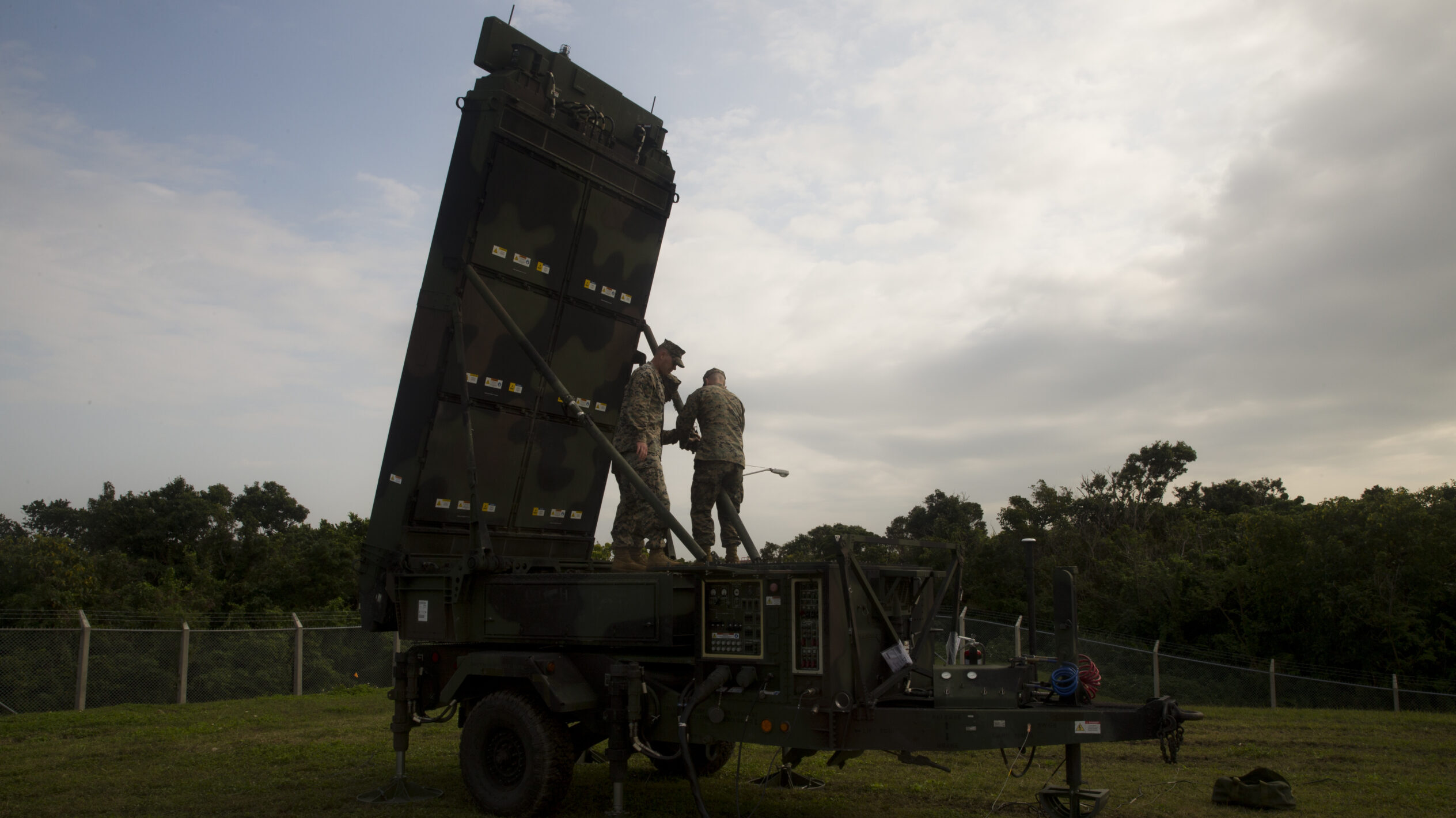
US Marines with Marine Air Control Squadron 4, Marine Aircraft Group 36 set up the AN/TPS-80 G/ATOR radar system on Marine Corps Air Station Futenma, Okinawa, Japan. (U.S. Marine Corps photo by Lance Cpl. Leo Amaro)
WASHINGTON — At a time when the Ukrainian military has shocked the world with its use of unmanned aerial drones, such as the Turkish Bayraktar TB2, the US Marine Corps is slowly moving towards the pinnacle milestone for its new expeditionary, air surveillance radar.
Following its successful test as part of the Marine Corps’ Medium-Range Intercept Capability earlier this year, the Ground/Air Task-Oriented Radar, or G/ATOR, has received multiples plaudits from the highest ranks of the Marine Corps, including just this week from the service’s second highest ranking officer, Gen. Eric Smith, who called the program a “phenomenal success story.”
Now, the program office is working towards a “significant test event involving [G/ATOR’s] Ground Weapons Locating Radar variant” scheduled for next year, according to the program office. Beyond that, a declaration for full operational capability, the acquisition milestone signaling the technology has met and achieved every expectation placed on it, is planned for 2025.
With the service moving full steam ahead on G/ATOR and officers such as Smith applauding it publicly, Breaking Defense thought the Marine Corps’ only “organic surveillance radar” was worth a closer look.
“The missions the United States had over the last 30 years, we’ve had — kind of dominance, right? You didn’t really worry where you put your radar,” said John Ferrari, a resident scholar at AEI and a former commander of White Sands Missile Range. “But if you go into war in the Pacific, or you’re going up against China or Russia… all of a sudden that becomes really important. It’s that ability to scoot-and-shoot and have a multi-mission radar.”
Produced by Northrop Grumman, G/ATOR is the Marine Corps’ all-weather “eyes” on the skies, able to detect drones, cruise missiles, rockets and mortars, as well as support counter-fire and targeting missions for tracking and destroying enemy munitions. Future upgrades will also assist with air traffic control missions by directing and regulating takeoffs and landings at airfields and bases.
And while the Pentagon has no shortage of varying air defense radar programs — Breaking Defense visited the production facilities for both a new Army and Air Force system earlier this year — what makes G/ATOR uniquely a Marine Corps program is its mobility, said Ferrari.
The Army has spent the past several decades operating out of fixed bases with little concern for being overrun by hostile forces, he said. That has translated into building larger radars that are not designed to be moved quickly once set up. But big, stagnant bases are not viable for the fight the Marines think they’ll face in the Indo-Pacific, and they are definitively not workable for the Ukrainian military as it defends itself against Russia.
“Think about Ukraine,” Ferrari said. “If you’ve got to guard the [High Mobility Artillery Rocket System], you want to put some radars and some counter-rockets around it. You can’t have something that requires a lot of power or can’t be moved because the radars themselves will be targets and killed.”
“Something like a G/ATOR would have enormous utility in Ukraine,” he added.
And in fact, G/ATOR’s utility in both theaters has already been tested to some degree. Without providing further details on precise operations, the G/ATOR program office told Breaking Defense the radar has “been utilized in numerous exercises and real-world operations during the past six months in both the Pacific and European areas of operation.”
“G/ATOR serves as the Marine Corps’ only organic surveillance radar and can operate worldwide, in any clime or place, to accomplish its mission objectives,” according to the program office. “Where the radar is employed depends solely on the units that require its particular functions and capabilities.”
The program is divided into three increments, or Blocks, with Block 1 representing the base surveillance and tracking capabilities. Block 2 incorporates the counter-fire and targeting missions that can be fed to defensive weapon systems, such as the Medium-Range Intercept Capability, while Block 4 is a future upgrade that is planned to provide air traffic control support, according to the program office. (The upgrades formerly called “Block 3” were integrated through individual engineering changes; the service no longer refers to those enhancements as “Block 3.”)
As with almost every major Marine Corps capability coming forward these days, G/ATOR has a specific and unique role within Commandant Gen. David Berger’s Force Design 2030 initiative, the overarching redesign of the Marine Corps to make it better suited for the future fight. In G/ATOR’s case, its role will be to help feed the massive networks the Pentagon is trying to build that will transport and analyze data across the battlefield and the joint force.
“The surveillance data provided by G/ATOR, along with the related systems that share that information with the broader surveillance network, are essential components that enable the [Marine Air Ground Task Force], the Joint Force Maritime Component Commander, and the Joint Force commander to sense and make sense of the operating environment,” according to the program office.
Sullivan says Ukraine supplemental should cover all of 2024, long-range ATACMS now in Ukraine
“We now have a significant number of ATACMS coming off their production line and entering US stocks,” Jake Sullivan said today. “And as a result, we can move forward with providing the ATACMS while also sustaining the readiness of the US armed forces.”


























